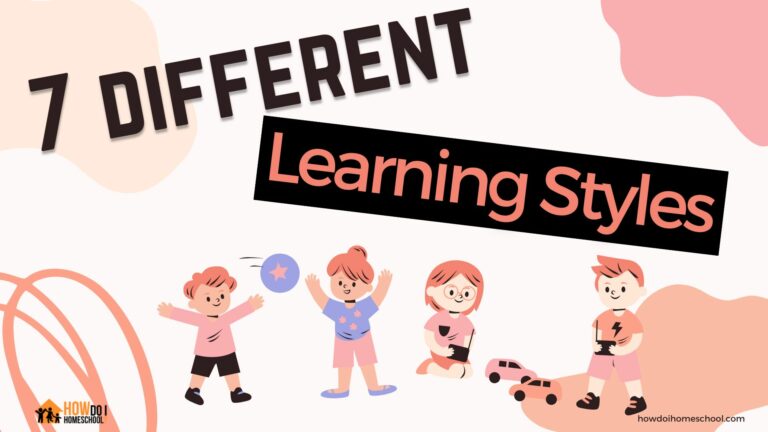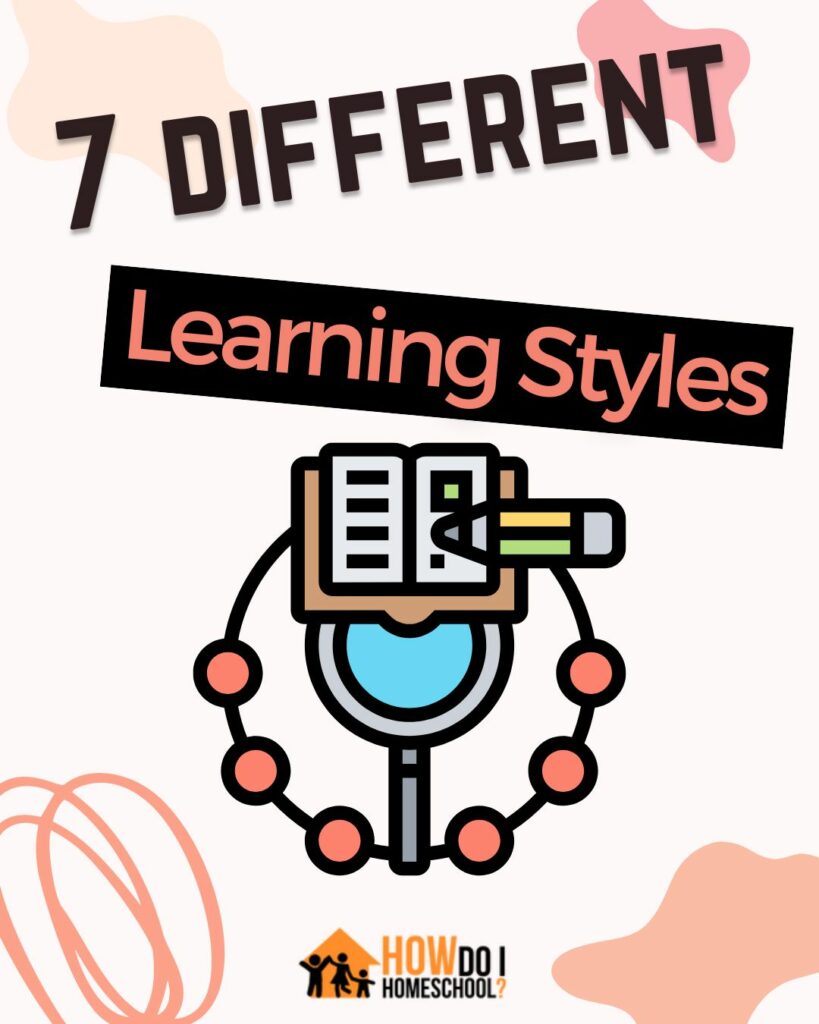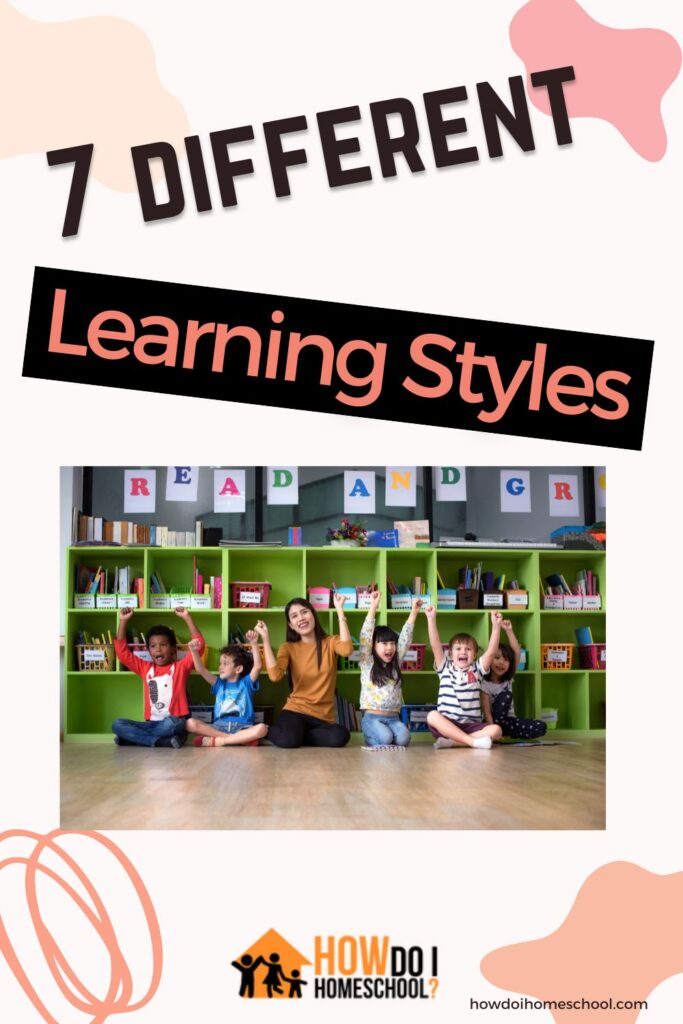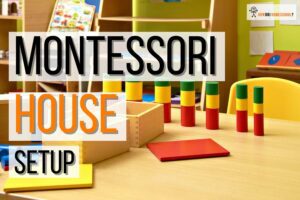Different people have different learning styles. Some people learn best by listening to audio recordings, others learn best by reading books, and others learn best by doing hands-on activities. Some people learn best in a classroom setting, while others learn best by working independently. There are many different ways to learn, and it is important to find the learning style that works best for you.

I hope you enjoy reading this blog post. If you want to do my course on how to homeschool, click here.
But is it important to pay attention to your kids learning style?
Yes. Let me explain why.
As kids, we believed in several myths and fairytales, from Santa Claus to the Tooth Fairy and the Boogeyman. As adults, the myths we believe often seem more realistic and could impact our children.
For instance, a common myth most parents seem to fall for is that all children learn the same way. Prop them in front of a blackboard, and they’d do just fine, right?
Wrong.
Over the last century, several studies have proven that children have unique ways of seeing the world. Remember the story of the blind men who went to visit an elephant? They all went to see the same animal but went away with different images and interpretations of what an elephant looks like.
Children are pretty much the same. They interpret concepts differently.
Thus, when it comes to learning, the “how” matters just as much as the “what.”
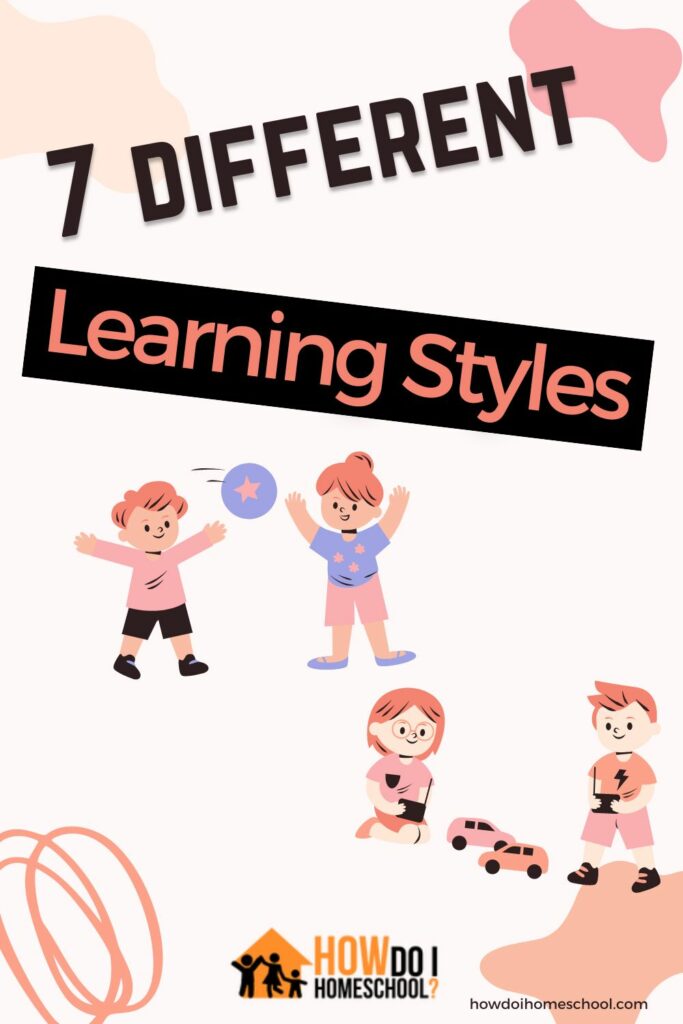
It’s essential to teach kids using their preferred learning styles. This guide will explore the different learning styles and proffer handy tips for identifying your child’s learning style.
Let’s get down to brass tacks, shall we?
What Do Learning Styles Mean?
Learning styles refer to theories that account for differences in how individuals learn. The general idea is that each student learns in their own way.
The term “learning style” was first recognized by Aristotle in 334 BC. Aristotle believed that each child possesses specific talents. After Aristotle’s utterance, researchers began to develop their own learning style theories.
One of the most popular learning style theories is the VARK model, developed by Neil Fleming. According to Fleming, students may prefer to assimilate or disseminate information in four ways: visual, aural, reading/writing, and kinesthetic instructional practices.
However, Howard Gardner, another theorist, offers a broader spectrum of learning styles.
According to Gardner, there are seven distinctive learning styles into which people can be categorized.
These categories include visual, auditory, kinesthetic, verbal (linguistic), logical (mathematical), social (interpersonal), and solitary (intrapersonal) learners. For the purpose of this guide, we’ll be exploring these different learning styles and what they mean.
Let’s get into it, shall we?
Visual Learners
Have you ever had a student who wouldn’t assimilate information until you painted a pretty picture?
Does this scenario sound familiar? If it does, chances are they were a visual learner. According to research, up to 65% of the general population are visual learners.
This means that there’s a high chance that you’re a visual learner too!
Visual learners often need to see information to process and assimilate it.
For instance, they may prefer to utilize tools like graphs, maps, diagrams, and even movies when learning and will typically retain information when presented in any of these formats.
Experts also suggest that the visual learning style could include people’s facial reactions and general body language. This means that a visual learner might focus more on how people are speaking than what they’re actually saying.
How to Identify a Visual Learner
So, here’s the big question: how do you know if your child is a visual learner? If you’re in any doubt about your child’s preferred learning style, here are some common visual learning traits to watch out for:
- They have an excellent memory for faces, not names: Can your child easily place random faces but struggle with people’s names? This is a common trait amongst visual learners.
- They’re observant but tend to miss some of what has been said: Most visual learners tend to pay extra attention to their surroundings, especially in class. However, despite their best efforts, they tend to forget some of what has been said. If your child exhibits this trait, it might signify that they’re a visual learner.
- They doodle a lot: Visual learners tend to doodle during classes. Although most parents and teachers erroneously take this as a sign of distraction, it’s their primary way of retaining information.
- They prefer to see charts and diagrams rather than listen in class: As mentioned earlier, visual learners prefer to process information through charts, diagrams, and images. If your child exhibits this trait, it’s a sign that visual learning is their preferred learning style.
How to Teach a Visual Learner
Teaching a visual learner might seem tricky, especially if you have limited resources. Fortunately, you don’t have to get a 3D robot to pull this off. Here are some seamless, easy-to-pull-off tips for teaching visual learners:
- Incorporate colors into your presentations and handouts: Studies have shown that visual learners have a strong sense of color and are often very color-oriented. Thus, incorporate colors into each lesson. This could mean using colored handbooks and chalk or simply hanging colorful posters in the learning area.
- Give written instructions rather than verbal ones: Visual learners often find it hard to remember verbal instructions. Thus, it’s better to write instructions down instead of relying on their memory.
- Show, don’t tell: Instead of telling your child how to carry out certain tasks, take a more hands-on approach. Show them how to do it by doing it yourself. This way, they’d be more likely to learn and retain what they’ve learned. You can also use free printable worksheets to demonstrate certain tasks. If you’re unsure where to find these tools, check out this company here.
- Show your child how to make vocabulary flashcards: Flashcards are a great way for visual learners (and students, in general) to learn and retain their knowledge of concepts. If you’re teaching your child new words, consider making colorful vocabulary flashcards and showing them how to make some of their own as well. This will help them as they go along their learning journey, especially if they’re visual learners. (You can easily create word-based games for kids with the help of word tools like unscrambled words.)
You can also check out some homeschool curriculum for visual learners here. But, I use the BJU Press curriculum with my own visual learners.
Aural Learners
Aural or auditory learners are polar opposites to visual learners.
Unlike the latter, this set of learners process information better through hearing or spoken words.
An auditory learner doesn’t care about diagrams, charts, and whatnot. In fact, they’ll prefer an audiobook to a physical book regardless of how colorful the latter may be.
According to research, aural or auditory learners make up about 30% of the world’s population. Typically, they love to engage in conversations and traditional lectures. Even when the lecture might seem boring, you’ll definitely find an aural learner paying close attention.
The best part? Aural learners can recall up to 75% of what they hear.
How to Identify an Aural Learner
Aural/auditory learners are pretty easy to spot. Here are some common aural learning traits to watch out for in your kid:
- They love to talk and listen: Aural learners are often quite talkative. In most cases, you’d find them heatedly engaging in discussions and debates. On the other hand, they also love to listen attentively. If your child pays extra attention during conversations or lectures, there’s a chance that they might be an aural learner.
- They prefer spoken instructions to written ones: Just like we mentioned earlier, aural learners prefer to listen to verbal instructions. With this group, you don’t need to write down instructions on a piece of paper.
- They can remember names easily: Unlike visual learners, auditory learners tend to remember names quite easily. They might struggle with placing faces, but they’ll almost certainly remember your name.
- They get distracted easily by background noise: Since aural learners prefer to process verbal information, they tend to get distracted when there are conflicting sounds in a room.
How to Teach an Aural Learner
While teaching an aural learner might seem pretty easy, you need to take care to disseminate information clearly and succinctly. Here are a few tips for teaching aural learners:
- Use audiobooks rather than printed textbooks: Printed textbooks are great, no doubt. However, they may not always work for auditory learners. If you’d like to help an aural learner get the most out of a teaching session, provide them with audiobooks. Here is a great audiobook to start on.
- Record lectures for repeated listening: If your child is an auditory learner, try to record lectures and learning sessions. This way, they can listen to the recordings over and over again.
- Use rhymes to help them memorize: Rhymes are always a good tactic for memorization, especially with kids. Use rhymes and mnemonics to help them process and memorize information.
If you have an auditory learner, check out Audible which is a platform with audiobooks on almost everything you could wish.
Kinesthetic Learners
Kinesthetic learners are also known as tactile learners. This group of people prefers to learn by “doing.”
They don’t want you to tell or show them how to complete a task. Rather, they want to roll up their sleeves and try it themselves. In essence, kinesthetic learners love hands-on experiences. They remember what has been done, not what has been said or displayed.
Thus, if you’re trying to present new information to a kinesthetic learner, simulations and examples are the best ways to pull this off. Let them try it out for themselves, and they’ll remember it later.
Kinesthetic learners can be quite complex and, thus, make up only about 5% of the general population.
How to Identify a Kinesthetic Learner
Kinesthetic learners are often mistaken for being nonchalant or truant because most parents and tutors don’t understand the complexity of this learning style. Here are some clear traits that will help you identify a kinesthetic learner:
- They don’t like to sit still: Kinesthetic learners often have trouble sitting still. During learning sessions, they might fidget or seem restless. They’re usually more at ease when they’re standing or moving about.
- They are distractible: Kinesthetic learners tend to get easily distracted in class, especially when it comes to visual and auditory classes. They’re poor listeners and may zone out when a conversation gets too long.
- They like to touch objects: This is a tricky trait, especially since most kids love to touch objects. However, for kinesthetic learners, this trait doesn’t go away even as they advance in age. They love to touch, feel, manipulate, and try out objects.
- They like to engage actively in learning: Kinesthetic learners are often active participants in hands-on learning. You’ll find them leading the way in group projects and outdoor activities.
How to Teach Kinesthetic Learners
Wondering how to teach a kinesthetic learner? Here are a few tips to ensure that they get the most out of the learning experience:
- Use computers: Computers are a great tool for kinesthetic learners. The constant tapping of keys will lessen the monotony of the class and help them feel less restless. Similarly, educational computer games allow them to practice what they’ve learned.
- Let them try out things for themselves: Letting your kid handle things like a can of paint or a tennis ball can seem daunting sometimes. However, the best way for kinesthetic learners to assimilate and retain information is when they try it out. So, let them try things out for themselves. Sure, things might get messy sometimes, but at the end of the day, you’ll find that you’ve achieved the ultimate learning goal.
- Role-playing and group work: Role-playing is also a great tool for kinesthetic learners. For instance, when teaching word problems, make them act out the problem, and then, you can solve it together. This active participation will help them assimilate and retain knowledge.
- Study in short-time periods: As we mentioned earlier, most kinesthetic learners get bored or restless when stuck in long classes. Thus, break lessons into short stints. For instance, after 20-30 minutes, you could go on a break and let them stretch their legs.
- Nature walks and nature study: Take children out into nature to let them discover things for themselves. Let them feel the bark on a tree. Let them sift through dirt to see what’s in it. Let nature be their kinesthetic teacher. You can look at how to do nature walkss in the video below.
Go for a Unit Studies curriculum if you have visual learners.
Verbal (linguistic) Learners
Verbal learners love words, whether spoken or written. They love to interact with text and in most cases, process information best when they’re writing notes down, talking, or reading about the topic.
More often than not, verbal/linguistic learners shy away from graphs and numerical information. Rather, they are drawn to novels, articles, textbooks, and just about any text-oriented learning material.
So, if your child loves reading and writing, this might be a sign that they’re a verbal/linguistic learner.
How to Identify a Verbal/Linguistic Learner
Do you think your child might be a linguistic learner? Here are a few key traits to watch out for
- They are avid readers: Most linguistic learners are avid readers. If your child blitzes through storybooks, novels, and textbooks at the speed of light, chances are that they fall under this category.
- They tend to remember what they’ve read: Verbal learners have no trouble retaining information that they learned through reading. If your child can easily remember something they read in passing a few weeks ago, they might be a verbal learner.
- They often write things down: Does your child often write down information, even the most mundane ones? This could tell you more than you know about their preferred learning style.
How to Teach Verbal/Linguistic Learners
If your child is a verbal learner, here’s how to ensure that they get the most out of each study session:
- Make them read textbooks: Since this group learns faster through reading, provide ample textbooks for your child to read on each subject.
- Allow them to write their ideas down: Always give your child the opportunity to write their ideas down, whether on a piece of paper or a digital device. This might slow down the learning session, but it’s important to let them learn through their preferred learning style.
A great curriculum for any learning style is Schoolhouse Teachers. They’re incredibly affordable and offer an unbelievable range of subjects.
Logical (mathematical) Learners
Unlike verbal learners, this group has no qualms with numbers and numerical information.
Logical learners are often scientifically inclined and are all about logic and numbers. Thus, they process information best when presented in an organized, methodical approach.
The best way to teach children who prefer the logical learning style is by integrating logic and numerical puzzles into each lesson.
How to Identify a Logical Learner
- They love math and numbers: Logical learners often turn out to be math whizzes. They love solving mathematical problems and thrive best in science subjects.
- They often struggle with creative activities: If your child often struggles with activities that require them to get creative (e.g, art or essay writing), it might be a sign that they’re a logical learner.
Social (interpersonal) Learners
Like the term implies, social (interpersonal) learners love social interaction.
They thrive when other people are involved in the learning activity. Most social learners absolutely love group projects and tend to perform better in learning situations where they can communicate with other students and receive constructive feedback.
Thus, you’ll always find a social learner engaging actively in group assignments.
On the other hand, they tend to lose confidence and may perform poorly on individual assignments. They may also struggle with distance/ online math learning.
Solitary (intrapersonal)
Solitary learners are polar opposites of social learners.
Unlike the aforementioned group, solitary learners prefer independent learning situations.
If your child is a solitary learner, you’ll find that they prefer to study alone in a quiet environment and may often struggle with group projects or noisy environments.
Why Do You Need to Know Your Child’s Preferred Learning Style?
You’re probably wondering: why so much ado about learning styles?
Well, it’s simple. Whether your child is in a traditional classroom or taking online math courses, their preferred learning style remains a primary consideration. Here’s why:
It Makes Learning More Efficient
The benchmark of any successful learning session isn’t when you make it through the class without any accidents or distractions. Rather, it’s when the learning goal has been achieved, and the student has fully assimilated the concept being taught.
Unfortunately, this isn’t achievable if they’re taught with the wrong learning style. For instance, if you try to teach a visual learner without images and visual depictions of the concept, they’d probably blank out halfway through the lesson.
On the other hand, using your child’s preferred learning style helps them understand the concept completely. In essence, it yields results, making the learning process more efficient and productive.
Keeps Students Engaged and Motivated
In 2009, Sandi Mann, alongside his co-researcher Andrew Robinson, released the findings of a study that shook the educational sector to its core.
According to Mann’s study, almost 60% of students find at least half of their lectures boring – with about 30% claiming to find most or all of their lectures boring. Although there are many reasons for this, it’s hard to ignore the traditional education system’s role in this statistic.
According to Mann, traditional lectures rarely allow for interaction and active learning.
Students often have to learn through the same methods, with no allowances being made for their different learning styles. The result? Boredom and unwillingness to engage with the lesson or learning materials.
However, you’ll be enlivening the learning process by understanding your child’s learning styles and catering to them.
Consequently, they’d engage more with the learning material and be more motivated to learn. If you’re lucky, they’ll begin to look forward to the next lesson!
It helps you improve interactions with your child
Interaction is a huge element of learning. If you don’t understand your child’s learning style, there’s a huge chance you’ll get frustrated when teaching them.
Maintaining a friendly and patient interaction can be hard when it seems like your best efforts aren’t yielding any results.
However, as you make efforts to understand your child’s preferred learning style, you’ll become more aware of your own learning style.
Sometimes, this might be the same as your child’s or vastly different.
Consequently, this new awareness will help to prevent frustration on both ends throughout the learning process.
Furthermore, it will help build communication and strengthen the bond between you and your child. A win for everybody!
The Bottom Line: Which Learning Style is Recommended by Professional Tutors?
When it comes to learning styles, kids often have a preferred style that they’ll stick to. The best learning style for your child isn’t the most popular one or the one used in traditional classrooms. Rather, the best learning style for your child is the one that works best for them.
Experts recommend that you take time to study your child and understand their preferred learning style. Once you’ve done this, adjust each learning session to suit and cater to this style. If they’re visual learners, punctuate your lessons with graphs and diagrams. On the other hand, audiobooks are certainly a worthy investment if they’re auditory learners.
God bless!
